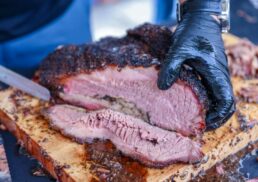There’s something magical about the aroma of freshly roasted coffee beans that can transform a simple cup of coffee into an extraordinary experience. Have you ever wondered how those beans are roasted to achieve that perfect flavor? In this blog post, we’ll explore the world of coffee roasters, guide you through selecting the perfect roasters machine, and share tips for achieving the perfect roast. So, let’s embark on this flavorful journey together and elevate your coffee game to new heights!
Table of Contents
Short Summary
Understand the different types of coffee roasters and their components to select the perfect machine.
Consider budget, size, capacity, ease of use/maintenance when choosing a coffee roaster for optimal performance & flavor.
Achieve desired roast with high quality beans & proper temperature control while following safety guidelines for ventilation & maintenance.
Understanding Coffee Roasters

Coffee roasters are essential tools in the coffee industry, transforming raw green coffee beans into the fresh roast that we all know and love. The roasting process not only develops the unique flavors and aromas of the roasted coffee beans, but also impacts their acidity, body, and overall taste, making them perfect for brewing at your favorite coffee shop.
With the right Kaldi home coffee roaster, you can unlock the full potential of your beans, allowing you to create a diverse range of roast profiles and specialty coffees with the help of a fresh roaster.
Types of Coffee Roasters
There are several types of coffee roasters available on the market, each with its own set of advantages and disadvantages. Drum roasters, for example, use a rotating drum to ensure even roasting of the beans. This method is particularly suitable for roasting specialty coffees, as it provides a consistent and uniform roast.
Air roasters, on the other hand, utilize hot air to roast the beans. These commercial coffee roasting machines are considered some of the best commercial coffee roasters in the industry due to their efficiency and ability to produce a consistent roast.
Lastly, fluid bed roasters employ hot air to roast the beans in a fluidized bed, making them a popular choice for coffee shops.
Components of a Coffee Roaster
A coffee roaster is made up of several key components that work together to create the perfect roast. The heating element is responsible for generating the heat required to roast the beans, while the drum or roasting chamber holds the beans and ensures even heat distribution.
The chaff collector, an often overlooked but crucial component, captures the chaff – the thin, papery skin that detaches from the beans during the roasting process. This not only helps maintain a clean roasting environment, but also prevents any potential fire hazards.
Selecting the Perfect Roaster Machine
When it comes to choosing the ideal coffee roaster machine, there are several factors to consider, such as budget, size, and personal preferences. Taking the time to research the reputation and quality of the roaster, as well as evaluating your specific needs and goals, will help you make an informed decision and ultimately select the machine that best suits your requirements.
It is important to remember that the right coffee roaster machine for you will depend on your individual needs.
Budget and Size
Your budget and available space are two crucial factors to consider when selecting a coffee roaster machine. While high-end machines often come with more features and better performance, they can also be more expensive and take up more space. On the other hand, more affordable and compact models may not offer the same level of control or versatility but could be more suitable for individuals with limited space or budget constraints.
Remember that the perfect roaster for you is the one that meets your needs and fits within your means.
Roasting Capacity
Another important factor to consider is the roasting capacity of the machine. This refers to the quantity of coffee beans that can be roasted simultaneously. Depending on your needs and the frequency of use, you may require a machine with a larger capacity for roasting bigger batches or a smaller one for more occasional use.
Assessing the roasting capacity based on your personal needs will help you choose a machine that is both efficient and practical for your specific situation.
Ease of Use and Maintenance
User-friendliness and maintenance requirements are also crucial factors to evaluate when selecting a coffee roaster machine. Some machines may have more advanced features and controls, which could be intimidating for beginners or those who prefer a more hands-on approach. On the other hand, a more user-friendly machine might be more suitable for individuals who are new to coffee roasting or simply want a hassle-free experience.
Additionally, consider how easy it is to clean and maintain the machine, as regular maintenance is essential for optimal performance and longevity.
Top 5 Coffee Roasters Machines of 2023
In the ever-evolving world of coffee roasting, 2023 has brought us some truly exceptional coffee roaster machines tailored for small batch roasting. Here is our curated list of the top 5 coffee roasters machines of 2023.
Jiawanshun Coffee Roaster Machine: This affordable and easy-to-use electric coffee roaster machine is perfect for those on a budget without sacrificing quality.
KALDI Best Personal Coffee Roaster: A top-tier small commercial coffee roaster machine with a long-term life expectancy, providing consistent and superior roasts.
North 500g Gas Coffee Roaster: Ideal for home use, this small batch coffee roaster delivers consistently high-quality roasts with satisfactory chaff management.
Mill City Roaster: Boasting the largest capacity on our list, this machine also features a USB port for data logging, providing ultimate control and customization options.
Huky Coffee Roaster: Highly recommended for its solid construction and numerous control options, including a gas option for those who prefer a more hands-on approach.
Gas vs. Electric Roasters
When it comes to choosing between gas-powered and electric coffee roasters, each type has its own set of pros and cons. Gas-powered roasters offer more precise temperature control and faster roasting times compared to electric models. This can result in a greater degree of control over the roasting process, allowing you to achieve the desired roast level with more accuracy.
On the other hand, electric roasters are often more affordable and easier to install, making them a popular choice for home users and small-scale operations. However, they may not offer the same level of control as gas-powered roasters, such as a gas stove, and their roasting times can be slower.
Ultimately, the choice between gas and electric roasters will depend on your personal preferences, budget, and desired level of control over the roasting process.
For more info, visit Gas vs. Electric roasters; The main differences.
Customizing Your Roast
Achieving the perfect roast is an art form, and the right coffee roaster machine can help you unlock a world of flavor possibilities. With a wide range of customization options, you can:
Create personalized roast profiles
Experiment with different bean varieties
Try different roast levels
Blend different beans together
To customize your roast, follow these steps:
Start by selecting high-quality green coffee beans.
Adjust the temperature and roasting time according to your desired roast level.
Monitor the roasting process closely and make adjustments as needed to achieve the perfect roast.
With some practice and experimentation, you’ll be able to create an array of unique and delicious roasts that cater to your specific tastes and preferences.
Tips for Achieving the Perfect Roast
To master the art of coffee roasting, it’s essential to pay attention to the finer details. Here are some tips to help you achieve the perfect roast:
Start with high-quality green coffee beans, as the quality of the beans will greatly impact the final flavor of your roast.
Ensure that you’re using the appropriate temperature and roasting time for your desired roast level. This may require some experimentation, but with practice, you’ll be able to fine-tune your roasting process.
Pay attention to the color and aroma of the beans during the roasting process. This will help you determine when the beans are roasted to your desired level.
Allow the roasted beans to cool completely before grinding or storing them. This will help preserve the flavor and aroma of the coffee.
By following these tips and paying attention to the details, you’ll be able to achieve the perfect roast every time.
Additionally, consider factors such as air flow and humidity, as these can also affect the roasting process. Make sure your roasting environment is well-ventilated and maintain a consistent temperature throughout the roasting process. By paying close attention to these factors, you’ll be well on your way to achieving the perfect roast and enjoying a delicious cup of coffee.
Coffee Roasting Safety and Ventilation
Proper ventilation and safety precautions are essential when using a coffee roaster machine at home. The roasting process generates smoke and fumes, which can pose a risk to your health if not properly ventilated. Additionally, the heat generated by the roaster can become a potential fire hazard if not managed correctly.
To ensure a safe roasting environment, follow these guidelines:
Make sure your roasting area is well-ventilated and free of any flammable materials.
Keep a fire extinguisher nearby.
Never leave the roaster unattended while in operation.
By adhering to these safety precautions, you can enjoy the process of roasting coffee beans at home without putting yourself or your home at risk.
Cleaning and Maintenance
Regular cleaning and maintenance of your coffee roaster machine are crucial for optimal performance and longevity. Over time, coffee residue and oils can accumulate within the machine, affecting its efficiency and the quality of your roasts. To keep your machine in top shape, clean the roasting chamber, drum, and chaff collector after each use, and regularly inspect the machine for any signs of wear or damage.
Additionally, check the ventilation system and ensure that it is functioning properly, as poor ventilation can lead to uneven roasting and potential safety hazards. By taking the time to properly clean and maintain your coffee roaster machine, you can ensure its optimal performance and enjoy consistently delicious roasts for years to come.
Summary
In conclusion, coffee roasting is a fascinating and rewarding process that allows you to explore the world of specialty coffees and create your own unique roasts. By understanding the different types of coffee roasters, selecting the perfect machine, and mastering the art of roasting, you can elevate your coffee experience to new heights. With the right tools, knowledge, and a little practice, you’ll be on your way to enjoying the unparalleled flavors and aromas of freshly roasted coffee beans in no time.
So embrace the art of coffee roasting and embark on a flavorful journey that will not only satisfy your taste buds, but also challenge and inspire you to create the perfect cup of coffee. Remember, the key to achieving the perfect roast lies in your passion, patience, and dedication to mastering the craft.
Frequently Asked Questions
What are the main types of coffee roasters?
The three main types of coffee roasters are drum, air and fluid bed roasters. Each type has its own unique set of advantages and drawbacks, so choosing the right one for you depends on your preferences and needs.
How do I choose the right coffee roaster machine for my needs?
Research the factors most important to you, such as budget, size, roasting capacity, ease of use, and maintenance requirements, when selecting a coffee roaster machine to ensure you find the right one for your needs.
Take the time to read reviews and compare different models to find the one that best suits your needs. Consider the features that are important to you, such as the size of the roaster, the capacity, the ease of use, and the maintenance requirements. Make sure to read the manufacturer’s instructions and warranty.
What is the difference between gas-powered and electric coffee roasters?
Gas-powered roasters offer more precise temperature control and faster roasting times compared to electric roasters, which are usually more affordable and easier to install.
How can I customize my roast using a coffee roaster machine?
Customize your roast by experimenting with different bean varieties, levels of roasting, and blending. This will create personalized profiles and unique flavors.
What safety precautions should I take when using a coffee roaster machine at home?
When roasting coffee at home, be sure to provide good ventilation and keep a fire extinguisher close by. Never leave the roaster running while unattended.









